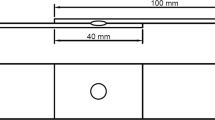Abstract
Among various defects formed in resistance spot welds of advanced high-strength steels (AHSSs), shrinkage void (cavity) is the least addressed topic. Although cavities are formed in numerous sizes and shapes, their influence on the strength and failure modes is yet to be investigated. The present study examines the effect of the cavity size and position on the peak tensile shear load and failure modes in 780 grade dual-phase steel used in automobile body structures. The size and position of the cavity in the nugget were varied carefully by altering the weld parameters and the sheet thickness. The cavity characteristics and its effect on the weld strength were evaluated from shear tensile tests and fracture surfaces. Results show that the size of the cavity increases with sheet thickness and nugget diameter. Further analyses revealed that the shear strength of the weld is influenced by the size and location of the cavity from the interface. A transition from plug-type failure to interfacial failure was observed with an increase in the cavity size. Consequently, the cavities reduce the load-carrying area of the nugget affecting the weld strength and failure mode. The effective nugget area, which is the actual load-bearing area of the nugget without any cavity inferred from the interfacial fracture surface, would be beneficial in determining the interfacial failures in resistance spot welds. Based on the results, a minimum nugget diameter of 5√t was proposed to obtain plug-type failures in AHSS spots with the cavity.



















Similar content being viewed by others
Data Availability Statement
The raw/processed data required to reproduce these findings cannot be shared at this time as the data also form part of an ongoing study.
References
M. Shome and M. Tumuluru, Introduction to Welding and Joining of Advanced High Strength Steels (AHSS), Welding and Joining of Advanced High Strength Steels (AHSS), M. Shome and M. Tumuluru, Ed., Woodhead, Sawston, 2015, p 1–8
M. Ashadudzzaman, I.D. Choi, J.W. Kim, D.G. Nam, and Y.D. Park, Effect of Initial (Reference) Welding Current for Adaptive Control and It’s Optimization to Secure Proper Weld Properties in Resistance Spot Welding, J. Weld. Join., 2015, 33, p 13–20
S.S. Park, Y.D. Park, K.H. Kim, Y.M. Choi, Y.M. Rhym, and N.H. Kang, A Comparison of Spot Weldability with Electrode Force Changes in Surface Roughness Textured Steel, J. Weld. Join., 2008, 26, p 75–84
N.T. Williams and J.D. Parker, Review of Resistance Spot Welding of Steel Sheets: Part 1—Modelling and Control of Weld Nugget Formation, Int. Mater. Rev., 2004, 49, p 45–75
H. Zhang and J. Senkara, Resistance Welding: Fundamentals and Applications, Taylor & Francis CRC Press, London, 2005
V. Vijayan, N. Huda, S.P. Murugan, J. Chanyoung, N. Seung Man, K. Namhyun, and Y.D. Park, The Weldability Study of Carbon Nanotube Based 2nd Generation Primer Coated Steel for Automotive Applications, J. Mech. Sci. Technol., 2017, 31(9), p 4405–4410
M. Pouranvari and S.P.H. Marashi, Critical Review of Automotive Steels Spot Welding: Process, Structure and Properties, Sci. Technol. Weld. Join., 2013, 18, p 361–403
X. Wan, Y. Wang, and C. Fang, Welding Defects Occurrence and Their Effects on Weld Quality in Resistance Spot Welding of AHSS Steel, ISIJ Int., 2014, 54, p 1883–1889
M. Pouranvari and E. Ranjbarnoodeh, Dependence of the Fracture Mode on the Welding Variables in the Resistance Spot Welding of Ferrite-Martensite DP980 Advanced High-Strength Steel, Mater. Technol., 2012, 46(6), p 665–671
D.C. Saha and Y.D. Park. Weldability and liquation Cracking Characteristics on Resistance-Spot-Welded High-Mn Austenitic Steel, in Trends in Welding Research 2012: Proceedings of the 9th International Conference, (ASM International, 2012), p. 330–334
R. Ashiri, H. Mostaan, and Y.D. Park, A Phenomenological Study of Weld Discontinuities and Defects in Resistance Spot Welding of Advanced High Strength TRIP Steel, Metall. Mater. Trans. A, 2018, 49, p 6161–6172
R. Ashiri, M. Shamanian, H.R. Salimijazi, M.A. Haque, J.H. Bae, C.W. Ji, and Y.D. Park, Liquid Metal Embrittlement-Free Welds of Zn-Coated Twinning Induced Plasticity Steels, Scripta Mater., 2016, 114, p 41–47
X.D. Liu, Y.B. Xu, R.D.K. Misra, F. Peng, Y. Wang, and Y.B. Du, Mechanical Properties in Double Pulse Resistance Spot Welding of Q&P 980 Steel, J. Mater. Process. Technol., 2019, 263, p 186–197
A. Joaquin, A. Elliott, and C. Jiang, Reducing Shrinkage Voids in Resistance Spot Welds, Weld. J., 2007, 86, p 24–27
M. Pouranvari, S.P. Hoveida Marashi, and H.L. Jaber, DP780 Dual-Phase-Steel Spot Welds: Critical Fusion-Zone Size Ensuring the Pull-Out Failure Mode, Mater. Technol., 2015, 49(4), p 579–585
M. Safari, H. Mostaan, and H.Y. Kh, Effects of Process Parameters on Tensile-Shear Strength and Failure Mode of Resistance Spot Welds of AISI, 201 Stainless Steel, Int. J. Adv. Manuf. Technol., 2017, 89(5–8), p 1853–1863
M. Marya and X.Q. Gayden, Development of Requirements for Resistance Spot Welding Dual-Phase (DP600) Steels Part 1—The Causes of Interfacial Fracture. Weld. J., 2005, 84(11), p 172s–182s
K. Chung, W. Noh, X. Yang, H.N. Han, and M.-G. Lee, Practical Failure Analysis of Resistance Spot Welded Advanced High-Strength Steel Sheets, Int. J. Plast., 2017, 94, p 122–147
Acknowledgments
Authors acknowledge the financial support received from Hyundai Motors Cooperation (HMC), Korea.
Author information
Authors and Affiliations
Corresponding author
Additional information
Publisher's Note
Springer Nature remains neutral with regard to jurisdictional claims in published maps and institutional affiliations.
Rights and permissions
About this article
Cite this article
Vijayan, V., Murugan, S.P., Son, SG. et al. Shrinkage Void Formation in Resistance Spot Welds: Its Effect on Advanced High-Strength-Steel Weld Strength and Failure Modes. J. of Materi Eng and Perform 28, 7514–7526 (2019). https://doi.org/10.1007/s11665-019-04465-6
Received:
Revised:
Published:
Issue Date:
DOI: https://doi.org/10.1007/s11665-019-04465-6




